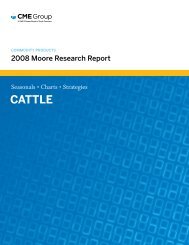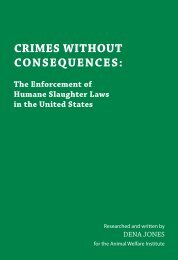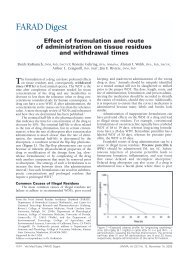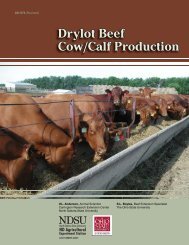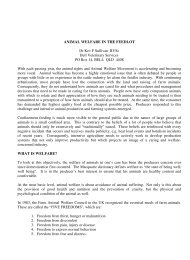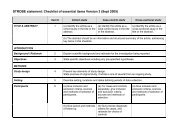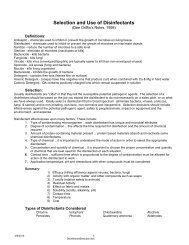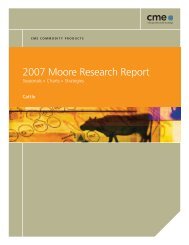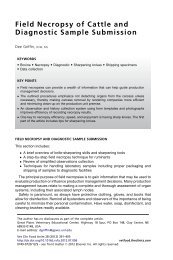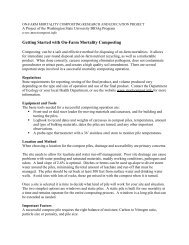Effect of management strategies on reducing heat stress of feedlot ...
Effect of management strategies on reducing heat stress of feedlot ...
Effect of management strategies on reducing heat stress of feedlot ...
Create successful ePaper yourself
Turn your PDF publications into a flip-book with our unique Google optimized e-Paper software.
3086<br />
ati<strong>on</strong> in water intake by animals is noteworthy. In the<br />
experiments reported herein, as in many experiments,<br />
water usage was measured rather than actual water<br />
intake. For c<strong>on</strong>trol cattle used in these experiments,<br />
water intake per unit <str<strong>on</strong>g>of</str<strong>on</strong>g> DMI ranged from 0.96 to 1.33<br />
L/kg.<br />
Alterati<strong>on</strong>s in eating pattern, as represented by bunk<br />
scores, were found in Exp. 1 during the 23-d managed<br />
feeding period as a result <str<strong>on</strong>g>of</str<strong>on</strong>g> limit feeding and restricted<br />
access to feed. Representati<strong>on</strong> <str<strong>on</strong>g>of</str<strong>on</strong>g> bunk scores within a<br />
treatment across envir<strong>on</strong>mental periods is useful in<br />
evaluating adaptive adjustments made by the steers as<br />
an effect <str<strong>on</strong>g>of</str<strong>on</strong>g> both treatment and envir<strong>on</strong>mental c<strong>on</strong>diti<strong>on</strong>s.<br />
Comparis<strong>on</strong>s across treatments results in limited<br />
interpretati<strong>on</strong> due to differences in bunk scores as a<br />
result <str<strong>on</strong>g>of</str<strong>on</strong>g> the imposed treatment.<br />
One behavioral adaptive change cattle undergo during<br />
<strong>heat</strong> <strong>stress</strong> is an alterati<strong>on</strong> in eating behavior such<br />
that a larger porti<strong>on</strong> <str<strong>on</strong>g>of</str<strong>on</strong>g> their intake is c<strong>on</strong>sumed during<br />
the late afterno<strong>on</strong> and early evening period (Cowan,<br />
1975; M<strong>on</strong>ty and Garbareno, 1978). The lower scores<br />
<str<strong>on</strong>g>of</str<strong>on</strong>g> the ADLIB treatment group for the MHS period in<br />
Exp. 1 suggest acclimatizati<strong>on</strong> was occurring by the<br />
cattle; however, the greater scores in HS2 indicate that<br />
under more severe <strong>heat</strong>, lowering DMI was used as a<br />
coping mechanism. For ADLIB steers (Figure 1), 50%<br />
<str<strong>on</strong>g>of</str<strong>on</strong>g> the pens were assigned a bunk score <str<strong>on</strong>g>of</str<strong>on</strong>g> 1 (10 to 50%<br />
<str<strong>on</strong>g>of</str<strong>on</strong>g> feed delivered remaining) during HS2 (d 21 to 22)<br />
compared with n<strong>on</strong>e during the other three periods at<br />
2100. Although mean (76 vs. 77) and maximal (82 vs. 83)<br />
THI were slightly lower during HS2 than HS1, minimal<br />
THI was slightly higher (69 vs. 67) for HS2. Hahn and<br />
Mader (1997) c<strong>on</strong>cluded that adequate nighttime recovery<br />
(THI ≤ 74) was needed to reduce death in vulnerable<br />
<strong>feedlot</strong> animals. Whereas THI during the night in Exp.<br />
1 was well below this threshold, these data support the<br />
c<strong>on</strong>cept that nighttime envir<strong>on</strong>mental c<strong>on</strong>diti<strong>on</strong>s play<br />
a key role in the <str<strong>on</strong>g>management</str<strong>on</strong>g> <str<strong>on</strong>g>of</str<strong>on</strong>g> <strong>heat</strong> <strong>stress</strong>.<br />
Steers in BKMGT treatment group showed no difference<br />
in bunk scores over the varying envir<strong>on</strong>mental<br />
periods, suggesting their intake patterns remained very<br />
c<strong>on</strong>sistent despite the changing envir<strong>on</strong>mental c<strong>on</strong>diti<strong>on</strong>s.<br />
A c<strong>on</strong>sistent feed intake pattern improves animal<br />
producti<strong>on</strong> (Soto-Navarro et al., 2000) by allowing for<br />
more efficient nutrient use (Zinn, 1994; Soto-Navarro<br />
et al., 2000). Steers <strong>on</strong> LIMFD during Exp. 1 altered<br />
their feeding pattern; however, results suggest that this<br />
alterati<strong>on</strong> seemed to be more <str<strong>on</strong>g>of</str<strong>on</strong>g> an effect <str<strong>on</strong>g>of</str<strong>on</strong>g> days <strong>on</strong><br />
feed than envir<strong>on</strong>mental c<strong>on</strong>diti<strong>on</strong>s. As days <strong>on</strong> the<br />
LIMFD regimen increased, steers became aggressive<br />
meal eaters regardless <str<strong>on</strong>g>of</str<strong>on</strong>g> envir<strong>on</strong>mental c<strong>on</strong>diti<strong>on</strong>s.<br />
One hour after feed delivery, during HS2, LIMFD steers<br />
had c<strong>on</strong>sumed the majority <str<strong>on</strong>g>of</str<strong>on</strong>g> their feed. Soto-Navarro<br />
et al. (2000) reported steers fed 90% <str<strong>on</strong>g>of</str<strong>on</strong>g> ad libitum intake<br />
twice daily c<strong>on</strong>sumed all feed <str<strong>on</strong>g>of</str<strong>on</strong>g>fered within 1 to 2 h. The<br />
fact that LIMFD steers in the current study remained<br />
aggressive in their eating pattern in spite <str<strong>on</strong>g>of</str<strong>on</strong>g> warmer<br />
envir<strong>on</strong>mental c<strong>on</strong>diti<strong>on</strong>s may have been due to their<br />
lower body temperature (Davis et al., 2003).<br />
Mader and Davis<br />
Sprinkling did not have a large effect <strong>on</strong> bunk scores<br />
<str<strong>on</strong>g>of</str<strong>on</strong>g> steers when it was the <strong>on</strong>ly <strong>heat</strong> <strong>stress</strong> relief method<br />
employed (Exp. 2 and 3). Under mild <strong>heat</strong> <strong>stress</strong>, differences<br />
between sprinkling treatments were noted; however,<br />
under severe <strong>heat</strong> <strong>stress</strong>, sprinkling did not alter<br />
feeding pattern. This is likely due to the cattle staying<br />
close to the sprinkled areas and not going to bunks<br />
to feed.<br />
Treatment differences were noted in marbling scores<br />
in two <str<strong>on</strong>g>of</str<strong>on</strong>g> the three experiments. These differences may<br />
be related to alterati<strong>on</strong>s in horm<strong>on</strong>al pr<str<strong>on</strong>g>of</str<strong>on</strong>g>iles caused by<br />
varying degrees <str<strong>on</strong>g>of</str<strong>on</strong>g> <strong>heat</strong> <strong>stress</strong> experienced by each <str<strong>on</strong>g>of</str<strong>on</strong>g><br />
the treatment groups. In the experiments, cattle exposed<br />
to greater <strong>heat</strong> <strong>stress</strong> tended to have greater<br />
marbling score.<br />
Kouba et al. (2001) examined the effect <str<strong>on</strong>g>of</str<strong>on</strong>g> prol<strong>on</strong>ged<br />
exposure to envir<strong>on</strong>ments <str<strong>on</strong>g>of</str<strong>on</strong>g> 31 or 20°C <strong>on</strong> fat depositi<strong>on</strong><br />
<str<strong>on</strong>g>of</str<strong>on</strong>g> pigs. Internal fat deposits were increased 2-fold in<br />
pigs reared in 31 vs. 20°C envir<strong>on</strong>ments, whereas backfat<br />
depositi<strong>on</strong> was similar. The difference in the locati<strong>on</strong><br />
<str<strong>on</strong>g>of</str<strong>on</strong>g> fat depositi<strong>on</strong> in resp<strong>on</strong>se to <strong>heat</strong> <strong>stress</strong> is important<br />
because excessive external fat depositi<strong>on</strong> can be detrimental<br />
to <strong>heat</strong> exchange capabilities. Mader et al.<br />
(1997) reported cattle fed during the winter in open<br />
facilities north <str<strong>on</strong>g>of</str<strong>on</strong>g> a windbreak that were subjected to<br />
mild cold <strong>stress</strong>, tended to have increased marbling and<br />
backfat values. However, steers finished in the same<br />
facility in the summer, when the prevailing southerly<br />
wind flow would be restricted, also had higher marbling<br />
compared with cattle finished in facilities where airflow<br />
was not restricted. Adequate airflow in the summer<br />
m<strong>on</strong>ths is needed for optimal animal performance<br />
(Mader et al., 1997), presumably to reduce <strong>heat</strong> <strong>stress</strong>.<br />
It would seem that slight <strong>heat</strong> <strong>stress</strong> might cause increased<br />
im. fat depositi<strong>on</strong>.<br />
Implicati<strong>on</strong>s<br />
Altering feeding time, feed amount, and water sprinkling<br />
are opti<strong>on</strong>s to decrease steers’ susceptibility to<br />
<strong>heat</strong> <strong>stress</strong>. Although enhanced productivity may be<br />
realized by using sprinklers in intensive beef cattle producti<strong>on</strong><br />
systems, producti<strong>on</strong> resp<strong>on</strong>ses to altered feeding<br />
regimens are not always obtained. However, preventing<br />
peaks in metabolic <strong>heat</strong> load from occurring<br />
during peaks in climatic <strong>heat</strong> load can be accomplished<br />
by altering feeding regimen, thereby minimizing animal<br />
discomfort during summertime <strong>heat</strong> episodes. Alterati<strong>on</strong>s<br />
in feeding regimen increase animal well being<br />
without adversely affecting performance. An altered<br />
feeding regimen enhances the animal’s ability to cope<br />
with metabolic and climatic <strong>heat</strong> load during the summer,<br />
whereas sprinkling cattle and/or <strong>feedlot</strong> surfaces<br />
serves to decrease overall <strong>heat</strong> load.<br />
Literature Cited<br />
Arkin, H., E. Kimmel, A. Berman, and D. Broday. 1991. Heat transfer<br />
properties <str<strong>on</strong>g>of</str<strong>on</strong>g> dry and wet furs <str<strong>on</strong>g>of</str<strong>on</strong>g> dairy cows. Trans. Am. Soc.<br />
Agric Eng. 34:2550–2558.




